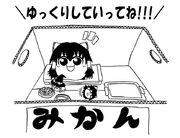
A simple yukkurarium made of cardboard.
A Yukkurarium is (from vivarium, an enclosed area such as an aquarium or a terrarium) is a usually enclosed area for keeping and raising yukkuris for observation, research or fun. Often, a portion of the ecosystem for a particular species is simulated on a smaller scale, with controls for environmental conditions.
A yukkurarium may be small enough to sit on a desk or table, especially one built for Pet Yukkuris bred to stay small for their entire lifespan (Mini-Yukkuris), or may be a larger structure, possibly outdoors. Some Yukkurariums may be adapted for a single species or a smaller group of yukkuris: for example an Aquatic Marisa may enjoy a yukkurarium with large bodies of water, whereas a common yukkuri would be repulsed and scared by it.
Some yukkurariums may be built with yukkuri abuse in mind, thus being built with unusual features, such as steep inclines and sandpaper flooring. This is designed to make Yukkuri uneasy and threatened.
Structure[]
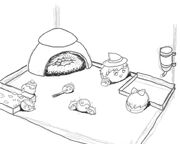
A well-stocked glass yukkurarium with water-and-food trays, toys, a place for excrement, and a house with nest and koyukkuri.
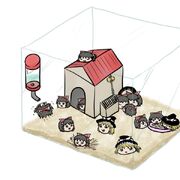
A not-so well stocked tank. Despite having a house, food tray, and water bottle, it's small and doesn't provide all the services needed to keep the yukkuri occupied.
A very simple yukkurarium, as the one showcased in the "yukkurarium game", is merely a tank of glass or plexigrass, large enough to house, a small number of yukkuris, and tall enough to avoid them from escaping. Aside from being useful to contain some unruly examples of the species this yukkurarium has several limits preventing pet yukkuris from taking it easy.
A more complex and useful yukkurarium may benefit by a soft floor, made of fine sand or soft soil in the warmer months, and fluffy cotton and wool in the colder ones, for better thermal insulation and ease of cleaning. It may also contain a corner with some tissues, or a discarded tissue box, to be used as a toilet, so that the yukkuri may be taught to defecate (doing poo poo) there and avoid fouling their whole living space (whereas in an unfurnished yukkurarium cleaning becomes easily a larger issue). This kind of yukkurarium may also contain a small pet house, or at least a small box with a cut-out opening, or even some toilet paper rolls for mini-yus or koyukkuris; yukkuris' genetic memory pushes them into living in small, secluded areas, such as caves and dens, thus they find dark, enclosed spaces to be "easy" and soothing.
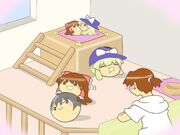
A pen-like cage for larger yukkuri.
To emulate their den they may be given some items and materials, such as rocks, tissues and so on, to be used as "furniture": a large rock may become their "Mister Table". Of course, the ideal yukkurarium must be big enough to allow an entire family to live comfortably, or at least a couple of yukkuri: yukkuri are social beings, thus a single yukkuri, left alone in an enclosed space for a long time, may end crying for its "Mister/Miss Owner" to come back, or even develop a case of Anti-yukkuritis: however, even a single yukkuri, especially if its a ko, may benefit from living in a secure area, thus avoiding the dangers of a large, furnished, human house, and may stave off loneliness of provided with adequate toys.
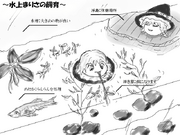
Aquatic Marisas in a well-stocked aquatic tank.
In colder climates a yukkurarium may be equipped with heating devices, thus avoiding the need for yukkuris to hibernate: in a similar way yukkuris may benefit from air conditioning. More complex (and big) yukkurariums may be placed outside. Those yukkurarium, taller and filled with earth, approximate closely yukkuri's natural habitat, allowing them to burrow and, if built well enough, allowing their owner to have a look at their dens and observe some peculiar behaviors yukkuris exibit only with a natural climate in a natural looking habitat (burrowing, hibernating, prepare themselves for winter and rain confinment...). However, as shown in Yukkurarium Family, most Pet Yukkuris, especially the ones bred in captivity and not tamed later in life, may prefer the simpler design, since they lack the ability to properly burrow and resist to the colder climates outside human houses.
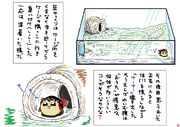
Another yukkurarium well suited for a single yukkuri. Notice how the Reimu is using the corner of the tank as a bathroom, compared to using the entire tank.
As mentioned, a yukkurarium may be personalized to meet the personal tastes of the owner and the need of a species: the owner of an Aquatic Marisa may, for example, build a Yukkurarium that's more akin to an Aquarium than a Terrarium, filling it with water and leaving small platforms with a toilet space, a "yu-home" and some place to store yukkuri food (whereas the owner of a Yukkuri Nitori may remove the platform altogether and plan an entire underwater solution), where the owner of a mini-yu may build a particularly small yukkurarium to keep on his/her desk.
Abusive yukkurariums are generally small and cramped, and as mentioned above, designed to make the yukkuris living within "uneasy". Such homes may have sandpaper flooring, spiky toys and objects, or at times nothing at all. However, given the life-span of abused yukkuri (save a few examples), most abusers simply end a yukkuri's life without it ever setting foot in a yukkurarium. "Light" abusers, those that either playfully bully their pets or decide in the end to not kill the yukkuri are more likely to have a comforting home for the yukkuri. Most of the time, the death-trap yukkurariums are built or bought by "professional" abusers, those who waste large amounts of time and money abusing yukkuri.
